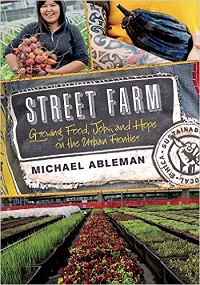 Typically, I don’t like books that claim to be the “ultimate” in the title as they usually disappoint. I brought this bias to a book from 2016 (but new to the Miller Library) titled “The Ultimate Guide to Urban Farming” by Victoria, British Columbia author Nicole Faires. I can’t claim expertise on urban farming and its many aspects, but I was very impressed by the thoroughness of this manual on the topic.
Typically, I don’t like books that claim to be the “ultimate” in the title as they usually disappoint. I brought this bias to a book from 2016 (but new to the Miller Library) titled “The Ultimate Guide to Urban Farming” by Victoria, British Columbia author Nicole Faires. I can’t claim expertise on urban farming and its many aspects, but I was very impressed by the thoroughness of this manual on the topic.
It’s important to first know the scope. This is not about edible landscaping or urban homesteading, the latter a term the author describes as “dabbling in a wide variety of self-reliant skills to raise food and make things for their own family like knitting, canning, and beekeeping.” By contrast, the goal of an urban farmer is “intensive food production near or in a city” with the intent of selling most of that food to others.
The author used the city of Havana, Cuba as a model. Forced to become self-sufficient without reliance on petroleum products following the end of the Soviet Union, this city of 2 million gradually developed a localized food system that she encourages Canadian and American cities to embrace. Faires also recognizes that “farms” come in all sizes, suggesting that balconies and window boxes, even indoor light gardens have the potential to be productive income sources.
After these preliminaries, the rest of “Urban Farming” is a systematic and meticulous review of the many, many crops one can consider, including those that might be used for purposes other than food. Besides the expected guidance on planting and growing, this includes the intricacies of harvest, storage, and selling your products. Raising a wide-ranging variety of animals for profit, including fish and shellfish, is also explored.
Excerpted from the Spring 2022 issue of the Arboretum Bulletin
Curious about what “alternative” agriculture is all about? Here is a playlist that explores why farmers grow food, growing food in cities, raising animals on pasture, restoring soil life by storing carbon in the ground and new methods of getting food to people. 9 videos, just shy of 3 hours.
Get familiar with alternative agriculture, urban farming, food systems and permaculture by reading a few good books. Peruse these curated collections of titles:
Borrowing Guidelines
News about the American food system with an emphasis on sustainability, equity, and social justice.
Information about biointensive farming, a method of farming well-suited to small spaces.
A comprehensive PDF booklet introduction to urban farming benefits, strategy, and practices.
Seattle Tilth, Tilth Producers and Cascade Harvest Coalition merged to form Tilth Alliance, “a nationally recognized non-profit organization dedicated to cultivating a sustainable community, one garden at a time.” Their mission is to build an ecologically sound, economically viable and socially equitable food system.

Street Farm is not a gardening book, but I’m reviewing it because it has a powerful message of the benefits of gardening, or – more accurately – urban farming, especially for those who do not have much else to bring hope and well-being to their lives. Author Michael Ableman is the co-founder of Sole Food Street Farms, a charitable organization that includes four farms on abandoned lots in downtown Vancouver, B. C. This book is the story of that organization and the people it has hired to become the urban farmers.
The neighborhoods around these farms are not tourist attractions. The author points out that “…while Vancouver’s prosperity is celebrated, its concentration of poverty and raw desperation endures in the midst of the polished and the preened.”
There are losses on these farms, both of the produce and of the humans who tend the crops, but overall this is a book of hope. Ableman is very clear that this endeavor is not a panacea for the challenges of poverty, mental health diseases, or addictions. He also recognizes his is a position of privilege by always having “…had a place to live and food to eat, and the color of my skin is not black or brown.”
Besides the human stories, all gardeners will relate to the challenges of growing plants in less than ideal circumstances, including outsmarting pests, in this case a sophisticated rat population that only chooses the best vegetables. No less interesting is the harvesting and marketing of crops to the more than 30 restaurants and five farmers markets that Sole Food supplies, plus its CSA (Community Supported Agriculture) shares and donations of over $20,000/year to community kitchens.
Excerpted from the Spring 2017 Arboretum Bulletin.
This 12 page booklet published by City of Seattle Department of Public Utilities will help beginning gardeners get started with growing vegetables and fruit in small urban spaces.
 Typically, I don’t like books that claim to be the “ultimate” in the title as they usually disappoint. I brought this bias to a book from 2016 (but new to the Miller Library) titled “The Ultimate Guide to Urban Farming” by Victoria, British Columbia author Nicole Faires. I can’t claim expertise on urban farming and its many aspects, but I was very impressed by the thoroughness of this manual on the topic.
Typically, I don’t like books that claim to be the “ultimate” in the title as they usually disappoint. I brought this bias to a book from 2016 (but new to the Miller Library) titled “The Ultimate Guide to Urban Farming” by Victoria, British Columbia author Nicole Faires. I can’t claim expertise on urban farming and its many aspects, but I was very impressed by the thoroughness of this manual on the topic.